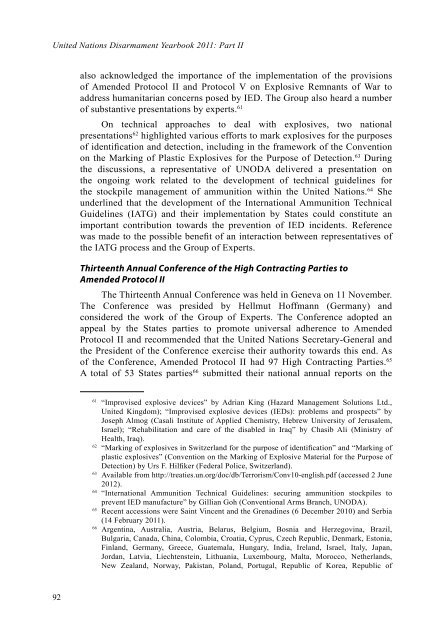DYB2011-Part-II-web
DYB2011-Part-II-web
DYB2011-Part-II-web
Create successful ePaper yourself
Turn your PDF publications into a flip-book with our unique Google optimized e-Paper software.
United Nations Disarmament Yearbook 2011: <strong>Part</strong> <strong>II</strong><br />
92<br />
also acknowledged the importance of the implementation of the provisions<br />
of Amended Protocol <strong>II</strong> and Protocol V on Explosive Remnants of War to<br />
address humanitarian concerns posed by IED. The Group also heard a number<br />
of substantive presentations by experts. 61<br />
On technical approaches to deal with explosives, two national<br />
presentations62 highlighted various efforts to mark explosives for the purposes<br />
of identification and detection, including in the framework of the Convention<br />
on the Marking of Plastic Explosives for the Purpose of Detection. 63 During<br />
the discussions, a representative of UNODA delivered a presentation on<br />
the ongoing work related to the development of technical guidelines for<br />
the stockpile management of ammunition within the United Nations. 64 She<br />
underlined that the development of the International Ammunition Technical<br />
Guidelines (IATG) and their implementation by States could constitute an<br />
important contribution towards the prevention of IED incidents. Reference<br />
was made to the possible benefit of an interaction between representatives of<br />
the IATG process and the Group of Experts.<br />
Thirteenth Annual Conference of the High Contracting <strong>Part</strong>ies to<br />
Amended Protocol <strong>II</strong><br />
The Thirteenth Annual Conference was held in Geneva on 11 November.<br />
The Conference was presided by Hellmut Hoffmann (Germany) and<br />
considered the work of the Group of Experts. The Conference adopted an<br />
appeal by the States parties to promote universal adherence to Amended<br />
Protocol <strong>II</strong> and recommended that the United Nations Secretary-General and<br />
the President of the Conference exercise their authority towards this end. As<br />
of the Conference, Amended Protocol <strong>II</strong> had 97 High Contracting <strong>Part</strong>ies. 65<br />
A total of 53 States parties66 submitted their national annual reports on the<br />
61 “Improvised explosive devices” by Adrian King (Hazard Management Solutions Ltd.,<br />
United Kingdom); “Improvised explosive devices (IEDs): problems and prospects” by<br />
Joseph Almog (Casali Institute of Applied Chemistry, Hebrew University of Jerusalem,<br />
Israel); “Rehabilitation and care of the disabled in Iraq” by Chasib Ali (Ministry of<br />
Health, Iraq).<br />
62 “Marking of explosives in Switzerland for the purpose of identification” and “Marking of<br />
plastic explosives” (Convention on the Marking of Explosive Material for the Purpose of<br />
Detection) by Urs F. Hilfiker (Federal Police, Switzerland).<br />
63 Available from http://treaties.un.org/doc/db/Terrorism/Conv10-english.pdf (accessed 2 June<br />
2012).<br />
64 “International Ammunition Technical Guidelines: securing ammunition stockpiles to<br />
prevent IED manufacture” by Gillian Goh (Conventional Arms Branch, UNODA).<br />
65 Recent accessions were Saint Vincent and the Grenadines (6 December 2010) and Serbia<br />
(14 February 2011).<br />
66 Argentina, Australia, Austria, Belarus, Belgium, Bosnia and Herzegovina, Brazil,<br />
Bulgaria, Canada, China, Colombia, Croatia, Cyprus, Czech Republic, Denmark, Estonia,<br />
Finland, Germany, Greece, Guatemala, Hungary, India, Ireland, Israel, Italy, Japan,<br />
Jordan, Latvia, Liechtenstein, Lithuania, Luxembourg, Malta, Morocco, Netherlands,<br />
New Zealand, Norway, Pakistan, Poland, Portugal, Republic of Korea, Republic of


